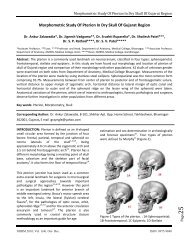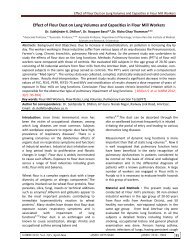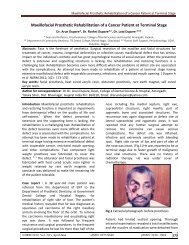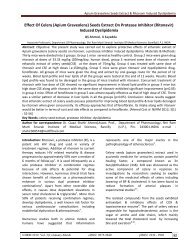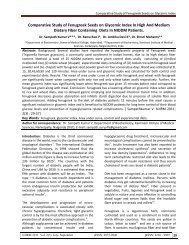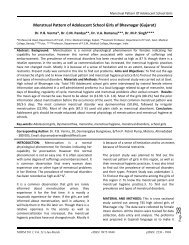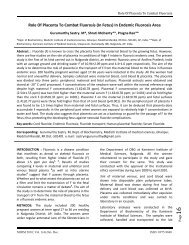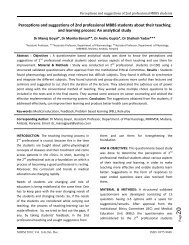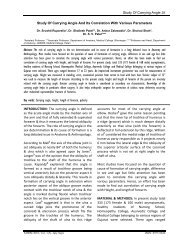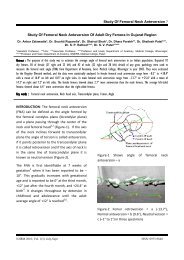Study of Antibiotic Sensitivity Pattern In Urinary Tract Infection At A ...
Study of Antibiotic Sensitivity Pattern In Urinary Tract Infection At A ...
Study of Antibiotic Sensitivity Pattern In Urinary Tract Infection At A ...
Create successful ePaper yourself
Turn your PDF publications into a flip-book with our unique Google optimized e-Paper software.
<strong>Antibiotic</strong> <strong>Sensitivity</strong> <strong>Pattern</strong> <strong>In</strong> <strong>Urinary</strong> <strong>Tract</strong> <strong>In</strong>fection<strong>Study</strong> <strong>of</strong> <strong>Antibiotic</strong> <strong>Sensitivity</strong> <strong>Pattern</strong> <strong>In</strong> <strong>Urinary</strong> <strong>Tract</strong> <strong>In</strong>fection <strong>At</strong>A Tertiary HospitalShalini*, Joshi MC*, Rashid MK # , Joshi HS***Department <strong>of</strong> Pharmacology, # Department <strong>of</strong> Micrbiology, ** Department <strong>of</strong> Community medicine, Rohilkhand Medical College &Hospital, Bareilly, U.P, INDIAAbstracts: This study was conducted in a tertiary hospital at Bareilly, Uttar Pradesh between Aug 2009 andJuly 2010 to check the changing pattern <strong>of</strong> antibiotic sensitivity among uropathogens causing urinary tractinfections (UTI). A total <strong>of</strong> 170 urine culture sensitivity reports were analyzed. The predominant growth <strong>of</strong>single bacteria was seen in 143 (84.12%) samples. The most common organisms isolated were Escherichia coli,klebsiella, pseudomonas, and Staphylococcus aureus. (These represented 64.33%, 92; 20.3%, 29; 9.1%, 13 and6.30%, 9 <strong>of</strong> isolates respectively). More than 80% <strong>of</strong> the isolates were sensitive to amikacin andnitr<strong>of</strong>urantoin, while more than 70% were sensitive to norfloxacin, cipr<strong>of</strong>loxacin and lev<strong>of</strong>loxacin. Very highrate <strong>of</strong> resistance was seen against cotrimoxazole (81.82%), amoxicillin (77.42%) and amoxi-clav (64.34%). E.coli showed high sensitivity to Amikacin 98.91% (91), Nitr<strong>of</strong>urantoin 93.48% (86). 75% <strong>of</strong> E. coli isolates weresensitive to minocycline, showing a good utility <strong>of</strong> this drug for the treatment <strong>of</strong> outdoor patients with urinarytract infections. [Joshi M C et al. NJIRM 2011; 2(3): 43-46]Key Words: <strong>Antibiotic</strong> <strong>Sensitivity</strong>, Uropathogens, <strong>Urinary</strong> <strong>Tract</strong> <strong>In</strong>fection.Author for correspondence: Dr. M. C. Joshi, Assistant Pr<strong>of</strong>essor, Department <strong>of</strong> Pharmacology, RohilkhandMedical College Hospital, Bareilly, Uttar Pradesh, <strong>In</strong>dia. Email- drjoshimukesh@rediffmail.com<strong>In</strong>troduction: <strong>Urinary</strong> tract infections (UTIs) aresome <strong>of</strong> the most common infections experiencedby humans, exceeded in frequency amongambulatory patients only by respiratory andgastrointestinal infections 1 . Neonates, girls, youngwomen, and older men are most susceptible toUTIs. <strong>In</strong> women, bacterial cystitis is the mostcommon bacterial infection. Every woman has a60% lifetime risk <strong>of</strong> developing bacterial cystitis,which develops mostly before the age <strong>of</strong> 24. Bycontrast, men have a lifetime risk <strong>of</strong> only 13% 2 . <strong>In</strong>children approximately 5% <strong>of</strong> girls and 1% <strong>of</strong> boyshave a UTI by 11 years <strong>of</strong> age 3 . It is also the mostcommon cause <strong>of</strong> nosocomial infections in adults.<strong>Urinary</strong> tract infection is said to exist whenpathogenic microorganisms are detected in theurine, urethra, bladder, kidney, or prostate with orwithout the presence <strong>of</strong> specific symptoms. <strong>In</strong>most instances, growth <strong>of</strong> more than 105organisms per milliliter from a properly collectedmidstream "clean-catch" urine sample indicatesinfection. However, significant bacteriuria is lackingin some cases <strong>of</strong> true UTI, especially insymptomatic patients, a smaller number <strong>of</strong>bacteria (102 to 104/mL) may signify infection. <strong>In</strong>urine specimens obtained by suprapubic aspirationor "in-and-out" catheterization and in samplesfrom a patient with an indwelling catheter, colonycounts <strong>of</strong> 102 to 104/mL generally indicateinfection. Conversely, colony counts <strong>of</strong> >105/mL <strong>of</strong>midstream urine are occasionally due to specimencontamination, which is especially likely whenmultiple species are found 4 . The vast majority <strong>of</strong>uncomplicated UTIs are caused by the Gramnegativebacillus Escherichia coli, with otherpathogens including Enterococci, Staphylococcussaprophyticus, Klebsiella spp. and Proteusmirabilis 5 . The extensive and inappropriate use <strong>of</strong>antimicrobial agents has invariably resulted in thedevelopment <strong>of</strong> antibiotic resistance which, inrecent years, has become a major problemworldwide 6 . <strong>In</strong> patients with suspected UTI,antibiotic treatment is usually started empirically,before urine culture results are available. Toensure appropriate treatment, knowledge <strong>of</strong> theorganisms that cause UTI and their antibioticsusceptibility is mandatory 7 . As both temporal andlocal variables can modify these data, they need tobe constantly re-evaluated to achieve a maximalclinical response before the antibiotic susceptibilitythe isolate is known. The aim <strong>of</strong> the present studywas to assess the changing susceptibility <strong>of</strong> urinarypathogens to antimicrobial agents in UTIs.Material and Methods A total <strong>of</strong> 250 urine culturesensitivity reports were analyzed <strong>of</strong> patients whowere suspected to be having urinary tractinfection, from Aug 2009 to July 2010 with priorNJIRM 2011; Vol. 2(3). July- September eISSN: 0975-9840 pISSN: 2230 - 9969 43
<strong>Antibiotic</strong> <strong>Sensitivity</strong> <strong>Pattern</strong> <strong>In</strong> <strong>Urinary</strong> <strong>Tract</strong> <strong>In</strong>fectionpermission from <strong>In</strong>stitutional Ethical Committee inRohilkhand Medical College & Hospital, Bareilly.Clean-catch midstream urine specimens frompatients diagnosed clinically to be having UTI onthe basis <strong>of</strong> symptoms (fever, dysuria & increasedfrequency <strong>of</strong> urination) were inoculated on BloodAgar and McConkey Agar plates, which wereincubated aerobically at 37 o C overnight. Platesshowing growth suggestive <strong>of</strong> significantbacteruria, with colony counts exceeding 10 5cfu/ml were subjected to standard biochemicaltests for identification and antimicrobial sensitivitytesting by Kirby- Bauer disc diffusion method.<strong>In</strong>terpretation as 'Sensitive' or 'Resistant' was doneon the basis <strong>of</strong> the diameters <strong>of</strong> zones <strong>of</strong> inhibition<strong>of</strong> bacterial growth as recommended by the discmanufacturer. <strong>Antibiotic</strong>s against which sensitivitywas tested in the present study includedAmoxycillin, Amoxiclav, Cipr<strong>of</strong>loxacin, Norfloxacin,Lev<strong>of</strong>loxacin, Co-trimoxazole, Gentamicin,Amikacin, Nitr<strong>of</strong>urantoin, Minocycline andCeftazidime.Result: A total <strong>of</strong> 170 urine culture sensitivityreports were analyzed in the present studybetween Aug 2009 and July 2010. The predominantgrowth <strong>of</strong> single bacteria was seen in 143 (84.12%)samples. The most common organisms isolatedwere Escherichia coli, klebsiella, pseudomonas, andStaphylococcus aureus. (These represented64.33%, 92; 20.30%, 29; 9.10%, 13 and 6.30%, 9 <strong>of</strong>isolates respectively). More than 80% <strong>of</strong> theisolates were sensitive to amikacin andnitr<strong>of</strong>urantoin, while more than 70% were sensitiveto norfloxacin, cipr<strong>of</strong>loxacin and lev<strong>of</strong>loxacin [Table1]. E. coli showed high sensitivity to Amikacin98.91% (91), Nitr<strong>of</strong>urantoin 93.48% (86) andceftazidime 80.43% (74) with good susceptibility toFluoroquinolones- {Lev<strong>of</strong>loxacin 75% (69),Norfloxacin 73.91% (68), Cipr<strong>of</strong>loxacin 69.56% (64)}and Minocycline 75% (69). The Klebsiella showedhighest sensitivity to Amikacin 89.65% (26) andNitr<strong>of</strong>urantoin 75.86% (22), while it was alsosusceptible to the Ceftazidime 68.96% (20) andFluoroquinolones {Lev<strong>of</strong>loxacin 72.41% (21),Norfloxacin 72.41% (21), and Cipr<strong>of</strong>loxacin 68.96%(20)} and Gentamicin 62.10% (18). Pseudomonasshowed highest sensitivity to Ceftazidime 84.62%(11) and Fluoroquinolones {Norfloxacin 76.92%(10), Cipr<strong>of</strong>loxacin 69.32% (9)} followed byAminoglycosides {Amikacin 61.54% (8), Gentamicin53.85% (7). The Staphylococcus aureus showedhigh sensitivity to Amoxiclav 88.9% (8), Amoxicillin77.8% (7), Nitr<strong>of</strong>urantoin 88.9% (8), Cipr<strong>of</strong>loxacin77.8% (7), Gentamicin 55.5% (5) [Table 2].Table 1- Overall Percentage <strong>of</strong> uropathogenssensitivity to <strong>Antibiotic</strong>s<strong>Antibiotic</strong> <strong>Sensitivity</strong> (%) Resistance (%)Amoxicillin 22.38% 77.42%Amoxi-clav 35.66% 64.34%Cotrimoxazole 18.18% 81.82%Gentamicin 63.64% 36.36%Amikacin 87.41% 12.59%Cipr<strong>of</strong>loxacin 73.43% 26.57%Norfloxacin 72.73% 27.27%Lev<strong>of</strong>loxacin 73.43% 26.57%Nitr<strong>of</strong>urantoin 81.12% 18.88%Ceftazidime 73.43% 26.57%Minocycline 53.15% 46.85%Table 2- <strong>Antibiotic</strong> <strong>Sensitivity</strong> & Resistance <strong>Pattern</strong> <strong>of</strong> Isolated Organism in UTIE.coli (n=92) Klebsiella (n=29) Pseudomonas (n=13) Staph.aureus (n=9)Sensitive Resistant Sensitive Resistant Sensitive Resistant Sensitive ResistantAmoxicillin 19.60% 80.40% 31.0% 69.0% ND 55.55% 46.15%Amoxi-clav 27.20% 72.80% 65.52% 34.48% ND 77.80% 23.1%Cotrimoxazole 19.60% 80.40% 10.34% 89.66% ND 55.55% 46.15%Gentamicin 66.30% 43.70% 62.10% 37.90% 53.85% 46.15% 55.55% 46.15%Amikacin 98.91% 1.09% 89.65% 10.35% 61.54% 38.46% NDCipr<strong>of</strong>loxacin 69.56% 30.44% 68.96% 31.04% 69.32% 30.68% 77.8% 22.2%Norfloxacin 73.91% 26.09% 72.41% 27.59% 76.92% 23.08% 66.70% 33.30%Lev<strong>of</strong>loxacin 75.0% 25.0% 72.41% 27.59% 61.54% 38.46% 77.77% 22.23%Nitr<strong>of</strong>urantoin 93.48% 6.52% 75.86% 24.14% ND 88.9% 11.10%Ceftazidime 80.43% 19.57% 68.96% 31.04% 84.62% 15.38% NDMinocycline 75.0% 25.0% 10.34% 89.66% 15.38% 88.89% 22.22% 84.60%NJIRM 2011; Vol. 2(3). July- September eISSN: 0975-9840 pISSN: 2230 - 9969 44
<strong>Antibiotic</strong> <strong>Sensitivity</strong> <strong>Pattern</strong> <strong>In</strong> <strong>Urinary</strong> <strong>Tract</strong> <strong>In</strong>fectionDiscussion: <strong>In</strong> community and hospital settings theetiology <strong>of</strong> UTIs and the antimicrobial susceptibility<strong>of</strong> UTI causing bacteria’s have been changing overthe years 8,9 . Over the last decade, the treatment <strong>of</strong>choice for urinary tract infections (UTIs) haschanged from co-trimoxazole to quinolones owingto the rate <strong>of</strong> resistance to co-trimoxazole and itshigh level <strong>of</strong> therapeutic failure 10 .Antimicrobialresistance has been associated with an increasedrate <strong>of</strong> clinical failure, and reports from Canadaand the US indicate that the prevalence <strong>of</strong>cotrimoxazole resistance exceeds 15% and can beas high as 25%. Use <strong>of</strong> fluoroquinolones isrecommended for uncomplicated UTIs in areaswhere the incidence <strong>of</strong> cotrimoxazole resistanceexceeds 10%, as well as for the treatment <strong>of</strong>complicated UTIs and acute pyelonephritis 5 .Amongst the bacteria causing UTIs, Escherichia coliremains a common aetiology (< or =60%), otherbacteria like Enterobacteriaceae other than E.coli,Gram-negative bacilli (e.g. Pseudomonasaeruginosa), and Gram-positive bacteria (e.g.Staphylococcus aureus) are frequently isolated.Patients with long-term catheterisation have UTIstypically caused by organisms that producebi<strong>of</strong>ilms making eradication even more difficult.Overall, aetiology and resistance patterns are notpredictable for those with serious UTIs,necessitating confirmation by culture andsusceptibility testing 11 .A total <strong>of</strong> 170 urine culture sensitivity reports wereanalyzed in the present study between Aug 2009and July 2010. The predominant growth <strong>of</strong> singlebacteria was seen in 143 (84.12%) samples. <strong>In</strong> ourstudy we found significant growth <strong>of</strong> Escherichiacoli, klebsiella, pseudomonas, and Staphylococcusaureus. These represented 64.33%, 92; 20.30%, 29;9.10%, 13 and 6.30%, 9 <strong>of</strong> isolates respectively.From this study, it can be seen that cotrimoxazoleand amoxicillin are virtually useless againsturopathogens causing UTI, as they were effectiveagainst 18% and 22% <strong>of</strong> all isolated organisms,respectively. Amoxiclav and minocycline wereslightly better and showed activity in 35% and 53%cases respectively. Some studies specificallyindicate the higher use <strong>of</strong> oral minocycline in lastfive years because <strong>of</strong> the higher susceptibility <strong>of</strong>uropathogens against minocycline 12 , probablybecause <strong>of</strong> good activity against E.coli which is alsoobserved in our study that E.coli isolates showed75% sensitivity.Our study suggests nitr<strong>of</strong>urantoin (81.12%susceptibility) or lev<strong>of</strong>loxacin (73.43%susceptibility) as the first-line drug against UTIbefore culture and sensitivity is done. Both werevery active against Escherichia coli and Staphaureus particularly. Both are cost-effective andreadily available in developing countries.Nitr<strong>of</strong>urantoin replaces lev<strong>of</strong>loxacin in case <strong>of</strong>pregnancy, since it has been shown to be very safein pregnancy 13 and also a recent study in <strong>In</strong>diashowed that Nitr<strong>of</strong>urantoin had the best in-vitrosusceptibility pr<strong>of</strong>ile against E.coli 14 . The consistentand high-level susceptibility <strong>of</strong> E. coli tonitr<strong>of</strong>urantoin may be influenced bynitr<strong>of</strong>urantoin's narrow spectrum <strong>of</strong> activity,limited indication, narrow tissue distribution, andlimited contact with bacteria outside the urinarytract 15 . Recently some studies have found anincreased microbial resistance to piperacillin,cephazolin, amikacin, and lev<strong>of</strong>loxacin.Additionally, extended-spectrum β-lactamase(ESBL)-producing E. coli tended to be isolated more<strong>of</strong>ten in these studies 12 .<strong>In</strong> another recent study 29.5% <strong>of</strong> E. coli weresuspected to produce extended-spectrum betalactamase(ESBL) and amikacin and nitr<strong>of</strong>urantoinwere the only drugs to which >90% <strong>of</strong> E. coli weresusceptible 16 . <strong>In</strong> the present study nitr<strong>of</strong>urantoinwas effective against 93% isolates <strong>of</strong> E.coli, 89%isolates <strong>of</strong> Staph.aureus and 76% <strong>of</strong> Klebsiella,compared to lev<strong>of</strong>loxacin which was effective in75%, 77% and 72% cases respectively, but with anadvantage <strong>of</strong> better activity against Pseudomonas(61% susceptibility). <strong>In</strong> our study E. coli showedhighest sensitivity to Aminoglycoside- Amikacin98.91% (91), along with good sensitivity toMinocyclines 75% (69).Conclusion: <strong>In</strong> conclusion one can truly affirm thatthe choice <strong>of</strong> drugs in the treatment <strong>of</strong> UTI is quitenarrow today due to the wide scale resistance thatthe common UTI pathogens show to drugs whichhave been used previously. Drugs likecotrimoxazole and aminopenicillins which wereNJIRM 2011; Vol. 2(3). July- September eISSN: 0975-9840 pISSN: 2230 - 9969 45
<strong>Antibiotic</strong> <strong>Sensitivity</strong> <strong>Pattern</strong> <strong>In</strong> <strong>Urinary</strong> <strong>Tract</strong> <strong>In</strong>fectionconsidered as effective against uropathogens, arenow rarely prescribed as empirical therapy in areaswhere resistance rate to theses antibiotics is high.But it is clear that nitr<strong>of</strong>urantoin, flouroquinolonesand minocyclines are good choices for thetreatment <strong>of</strong> outpatients. To tackle the upcomingproblems <strong>of</strong> ESBL producing E.coli, nitr<strong>of</strong>urantoin isagain a good choice along with amikacin.References:1. Levi ME, Redington J, Barth L. The Patient With<strong>Urinary</strong> <strong>Tract</strong> <strong>In</strong>fection. Manual <strong>of</strong> Nephrology6th Edition. Lippincott Williams & Wilkins.2005; 7: 91.2. Nicole W, Jon DM. Deciphering Dysuria. EmergMed. 2008; 40(9): 29.3. Jenson BH, Baltimore RS. <strong>In</strong>fectious Diseases.Nelson Essentials <strong>of</strong> Pediatrics 5th edition.Elsevier <strong>In</strong>c. 2006; p.522.4. Stamm WE, Schaeffer AJ. The State <strong>of</strong> the Artin the management <strong>of</strong> <strong>Urinary</strong> <strong>Tract</strong> <strong>In</strong>fections.Am J Med 2002; (suppl 1 A): 113.5. Blondeau JM. Current issues in themanagement <strong>of</strong> urinary tract infections:extended-release cipr<strong>of</strong>loxacin as a noveltreatment option. Drugs. 2004; 64(6): 611-28.6. Goldstein FW. <strong>Antibiotic</strong> susceptibility <strong>of</strong>bacterial strains isolated from patients withcommunity-acquired urinary tract infections inFrance. Multicentre <strong>Study</strong> Group. Eur J ClinMicrobiol <strong>In</strong>fect Dis. 2000; 19:112-7.7. Ashkenazi S, EvenTov S, Samra Z, et al.Uropathogens <strong>of</strong> various childhoodpopulations and their antibiotic susceptibility.Pediatr <strong>In</strong>fect Dis J. 1991; 10: 742–6.8. New HC. <strong>Urinary</strong> tract infections. Am J Med.1996; 100 (Suppl.4A): S63-70.9. Jones RN. Impact <strong>of</strong> changing pathogens andantimicrobial susceptibility pattern intreatment <strong>of</strong> serious infections in hospitalizedpatients. Am J Med. 1996; 100 (Suppl.6A): S3-12.10. Yilmaz K, Nilay C, Aysegül G, et al. Cotrimoxazoleand quinolone resistance inEscherichia coli isolated from urinary tractinfections over the last 10 years. <strong>In</strong>ternational JAntimicrbial Agents. 2005; 26 (1): 75-77.11. Carson C, Naber KG. Role <strong>of</strong> fluoroquinolonesin the treatment <strong>of</strong> serious bacterial urinarytract infections. Drugs. 2004; 64(12):1359-73.12. Shigemura K, Tanaka K, Adachi M, et al.Chronological change <strong>of</strong> antibiotic use andantibiotic resistance in Escherichia coli causingurinary tract infections. J <strong>In</strong>fect Chemother.2011; Apr 14. [Epub ahead <strong>of</strong> print].13. Delzell JE Jr, Leferre ML. <strong>Urinary</strong> tractinfections during pregnancy. Am FamPhysician. 2000; 61(3): 713-721.14. Biswas D, Gupta P, Prasad R, et al. Choice <strong>of</strong>antibiotic for empirical therapy <strong>of</strong> acute cystitisin a setting <strong>of</strong> high antimicrobial resistance.<strong>In</strong>dian J Med Sci. 2006; 60: 53-58.15. James AK, Laurie J, Clyde T, et al. Trends inAntimicrobial Resistance among <strong>Urinary</strong> <strong>Tract</strong><strong>In</strong>fection Isolates <strong>of</strong> Escherichia coli fromFemale Outpatients in the United States.Antimicrob Agents Chemother. 2002; 46(8):2540-2545.16. Bours PH, Polak R, Hoepelman AI, et al.<strong>In</strong>creasing resistance in community-acquiredurinary tract infections in Latin America, fiveyears after the implementation <strong>of</strong> nationaltherapeutic guidelines. <strong>In</strong>t J <strong>In</strong>fect Dis. 2010;14(9): 770-4.NJIRM 2011; Vol. 2(3). July- September eISSN: 0975-9840 pISSN: 2230 - 9969 46



